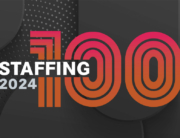The world of recruiting and staffing is becoming more complex and technology driven as a variety of converging trends affect the industry. From the “Uberization” of the on-demand workforce to changes in clients’ buying habits to robotic process automation and more, staffing leaders need to adapt quickly to turn disruptive obstacles into rain-making opportunities.
Many owner-operators with limited budgets view disruption as a threat to their core business, but the fact is that they can’t continue doing things the same way, according to Tom Kosnik, president and founder of organizational consulting firm Visus Group.
Small firms are facing a Catch-22. Rising operating costs and lower productivity have eaten into their net profits — money they need to invest in technology to break the cycle and invigorate growth.
One thing is certain: The staffing industry will never again look like it once did as we approach 2025, with these five trends leading the way.
The ‘Uberization’ of Staffing
Uber has already used its innovative mobile technology to upend the taxi industry — and now it has set its sights on staffing.
The ride-hailing giant flexed its transformational muscles when it launched Uber Freight, an app that matches truckers to companies that have goods to be moved, followed by Uber Works, which matches temporary workers with potential gigs. Uber Works isn’t the first company to connect the burgeoning on-demand workforce with potential employers, either.
Will Uber’s foray into staffing disrupt the entire industry? It’s hard to say, claim industry observers. Regardless, companies like Uber and Lyft certainly have the ability to push the industry’s technologically forward in ways that benefit everyone.
For instance, the shift to native mobile apps and mobile staffing solutions is being driven by a growing freelance workforce that expects to connect with projects and short-term gigs through their smart phones, thanks to Uber’s influence. To put things into perspective, Maurice Fuller, founder of the StaffingTec Conference, calls Uberization the most significant transformation he’s seen in the staffing industry in the last 25 years.
“The Uber business model is transformative not only because candidates want it, but because it accelerates the staffing process and delivers breakthrough results,” says Fuller.
Much like its ride-hailing service, Uber will also use an algorithm to set the wages for jobs that employers list on its app.
With record talent shortages, staffing firms that want to continue handling high-volume staffing or shift work will need to revitalize their existing operations, automate their staffing processes and invest in tools that create an Uber-like experience, if they want to survive.
Uber has also raised expectations around contingent worker pay.
“Much like Uber is now serving as a bank for its drivers, staffing firms will need to provide instant pay by the gig or the hour to compete for local workers in the future,” notes Art Papas, Bullhorn’s founder and CEO.
At the same time, Uber, which is facing legal challenges over pay, benefits and employee status, is creating opportunities for traditional staffing firms that have the wherewithal to manage risk.
For instance, as much as Uber is trying to become a staffing firm, it’s really more of a VMS because it is partnering with TrueBlue to provide employer-of-record services, Papas notes.
What’s more, replacing manual staffing processes with technology could help level the playing field for smaller staffing firms and open the door to new staffing alliances, talent pools and concepts such as surge pricing for workers with in-demand skills who accept assignments on short notice.
Digital Marketing a Must
If your sales team is making fewer connections and placements, you’ve got problems, but at least you’re not alone. Across industries and companies, traditional sales teams faces extinction. “The preferred means of communication is changing,” Kosnik says. “Even if you manage to get a prospective client’s attention by delivering a compelling, value-driven message, they are still going to research your company on the internet before they decide to engage.”
If you spent $5,000 on a website instead of $25,000, that decision could cost you millions in business.
Worse, millennials find the thought of making phone calls terrifying. That’s where digital marketing comes in.
The shift in the way that prospective clients make buying decisions has made digital marketing a must for any staffing firm that’s trying to compete in the modern marketplace. And not just social media. To succeed, a sales team needs the support of a robust, integrated digital marketing strategy that features high-quality content including blog posts, videos, case studies and a professional website.
Digital engagement is a precursor to action and an effective way to create inbound sales leads.
It’s time to stop asking, “What is digital marketing?” and start investing in it.
“If you’re selling the same way you were 18 months ago, you’re losing ground,” Kosnik warns. “Hire an outside firm to handle digital marketing and set rm goals to measure effectiveness.”
Increasing Regulations an Opportunity
While it’s true that staffing firms will need to adapt their policies and processes to comply with the growing maze of diverse regulations regarding worker sick leave, PTO, IC qualification, overtime and privacy laws like the California Consumer Privacy Act — the increasing burden actually reinforces the importance and value of the industry’s contributions.
“In a way, the crazy politicians are our friends because companies can’t deal with today’s increasingly complex legal environment by themselves,” Kosnik says. “HR departments can’t do what we can do in terms of managing thousands of flexible workers in varying locations, where different laws apply.”
For instance, the US Department of Labor currently administers and enforces more than 180 federal laws. On top of that, state governments will be implementing sweeping changes to dozens of laws in 2020, and there’s no end in sight.
In the short term, staffing leaders will need to figure out how the new privacy laws apply to the way they contact candidates, collect data, hold data and share data.
However, as Papas points out: “Those who adapt first and are fast to change will win.” So, in the long term, increasing regulations will create opportunities for staffing rms that make an effort to comply.
Hiring Disruption
A global talent shortage that could reach 85.2 million people by 2030 is already disrupting the ways top-performing recruiters approach their craft and businesses source full-time and contingent talent.
For example, contingent staffing firms and their clients are increasingly embracing grow-your-own strategies to mitigate against ongoing skill shortages. In fact, the American Staffing Association has pledged that US staffing agencies will provide training, upskilling and reskilling opportunities to 700,000 temporary and contract employees and job seekers during the next five years.
“The era of keyword searches and matching candidates’ previous experience to job descriptions has passed,” according to Jacob Morgan, author, speaker and futurist focusing on the employee experience and the future of work.
Recruiters will need to evaluate and highlight someone’s potential, aptitude and transferable skills — rather than what they have already achieved — to identify and recommend outside-the-box candidates that hiring managers may have previously overlooked. Morgan further warns that transaction-oriented staffing firms are going to feel the most disruption from what he calls the “death of hiring by paradigm.”
The bar has been raised. As global talent markets become more dynamic and competitive, recruiters need to take on a more proactive, strategic and advisory role with passive candidates and business managers. This requires advanced soft skills like open-mindedness and big-picture thinking along with access to AI-powered tools and platforms that use data-driven hiring techniques, algorithms, machine learning and even gamification to predict someone’s future performance in a specific role.
Finally, because hiring managers will need to consider a broader range of talent for completing the tasks at hand, we will continue to see the growth of talent marketplaces consisting of external freelancers, agency contractors and even internal employees. American Express, Google, and IBM are examples of organizations that are using AI to power internal talent development and marketplaces.
Intelligent Process Automation
Many staffing firms with revenue under $7 million are still relying on paper-based processes and timecards, but thanks to intelligent process automation of the front, middle and back office, they are beginning the journey toward transformative change and enhanced productivity.
“Automating workflows hasn’t been a priority,” Fuller says. Now, even small staffing firms can automate and eliminate repetitive, low-value and time-consuming administrative tasks across the staffing continuum — including sales and marketing — that currently take staff members away from interacting with candidates and clients. The real value of robotic process automation is that it takes “the robot out of the human.”
From entering notes in the system, candidate screening, follow-up emails and onboarding, to scheduling appointments, contract and credit management, commissions and global invoicing, letting “robots” complete busy work in the cloud is a game-changer that may help staffing professionals develop more creative talent solutions and build deeper relationships.
Experts may disagree on how the future of staffing is going to pan out, but one thing is clear: Robotic process automation and the Uberization of the industry are going to make it an interesting ride. Hold on tight.







